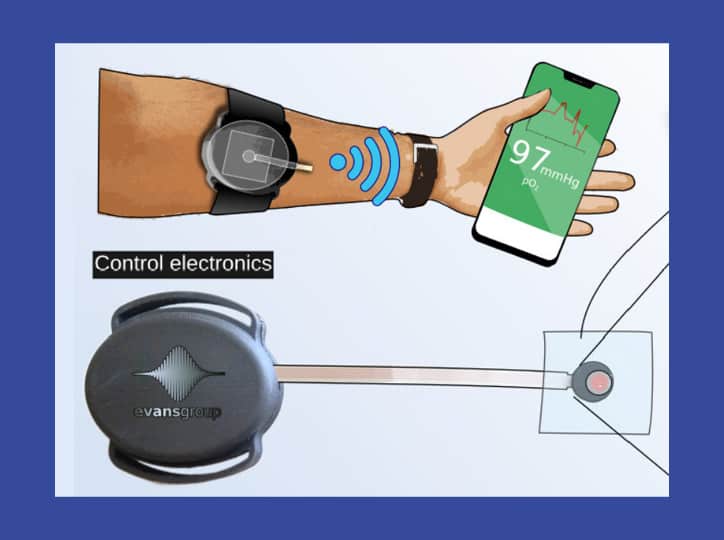Researchers have combined a new oxygen sensing film with machine learning to create a wearable sensor capable of measuring tissue oxygenation through skin. The device could be used to monitor a person’s oxygen levels on a continuous basis for applications in medicine and sports.
The wireless device is easy to operate and communicates wirelessly, making it well suited for remotely monitoring oxygen levels outside of healthcare settings.
“The device is intended for any scenario where there is a risk of compromised blood flow and a lack of oxygen to limbs and tissues”, said Conor Evans, the principal investigator on the project. “The technology is particularly powerful for medical situations where the traditional blood oxygen saturation tools fail to provide adequate information. The applications of this wearable wireless oxygen device range from traumatic injuries such as car accidents and battlefield injuries to post-surgical monitoring and wound care.”
Juan Pedro Cascales and Conor L. Evans from Massachusetts General Hospital and Harvard Medical School will present the research at the virtual OSA Imaging and Applied Optics Congress and Optical Sensors and Sensing Congress to be held 19-23 July.
The device, worn like a wristwatch midway up the forearm, consists of a 3D printed casing, a small sensor head and adhesive oxygen sensing film. Electronic components process data from the sensor and allow the device to send recordings via Bluetooth or Wi-Fi.
The sensor works by detecting the phosphorescence lifetime and intensity of an acrylic oxygen sensing film. Two LEDs in the sensor head excite the oxygen sensing film with ultraviolet light. A photodiode detects the phase of light emitted by the oxygen sensing film in response. Comparing the phase of the light emitted by the LEDs with the phase of light emitted by the oxygen sensing film provides a measure of the oxygen level in the tissue under the film.
“This is the first truly wearable noninvasive transcutaneous oxygen monitor,” said Juan Pedro Cascales, lead author on the project. “The simplicity, accuracy, small size, and ease-of-use of the device means it can go just about anywhere and be used by doctors, nurses, paramedics, and well as patients in their own home.”
To calibrate the sensor, researchers exposed the device to a variety of temperatures inside a chamber with a mix of nitrogen and air and adjusted the calibrations until the phases aligned with those of a commercial sensor.
The researchers tested the device by attaching it to the front limb of a Yorkshire pig. When a tourniquet was applied over the elbow joint, the sensor detected a drop in oxygen reflecting the reduction in blood flow. The measurements were well aligned with those from a commercial reference sensor and were not affected by variations in temperature, humidity or other environmental factors, making the sensor practical for use outside the lab.
The team used a machine learning approach to train the system to accurately measure oxygen levels under different conditions. This approach also allowed researchers to account for photobleaching, the tendency for light-excited materials to gradually lose their ability to emit light. Photobleaching is a common limitation of devices based on measuring light intensity.
“We are now carrying out first-in-human clinical trials, and are excited to share our results soon” said Evans. “We are also building smaller, more ergonomic and optimized versions of the device that can communicate with any smartwatch, smartphone, tablet, or computer,” added Cascales.
The innovate project has been funded by the Department of Defense through both the Military Medical Photonics Program as well as the Transforming Technologies for the Warfighter Program.


